Top 10
Epic Find
By DANIEL WEISS
Monday, December 10, 2018
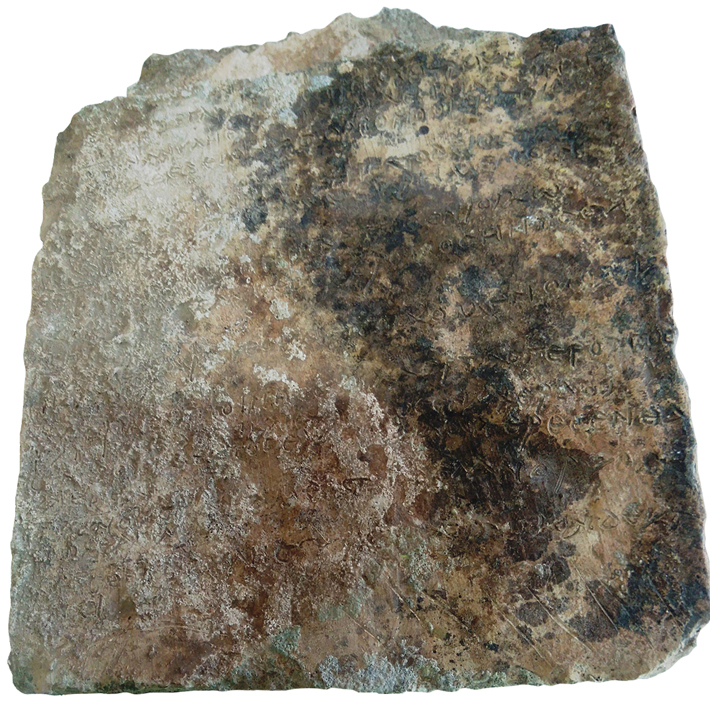 When an inscribed brick was first found amid a heap of discarded building material in a village outside the sanctuary of Zeus at Olympia, it appeared to be nothing special. Now, to researchers’ great surprise, they have learned it contains an excerpt from the Odyssey, the epic poem that tells of the Greek hero Odysseus’ 10-year journey following the Trojan War. The poem, which relates events of the twelfth century B.C., is thought to have been composed in the eighth century B.C. and was first written down in the sixth century B.C. Based on the style of its lettering, researchers have dated the newly discovered excerpt to the third century A.D. at the latest. They believe it is likely the oldest inscribed section of the Odyssey ever found in Greece.
When an inscribed brick was first found amid a heap of discarded building material in a village outside the sanctuary of Zeus at Olympia, it appeared to be nothing special. Now, to researchers’ great surprise, they have learned it contains an excerpt from the Odyssey, the epic poem that tells of the Greek hero Odysseus’ 10-year journey following the Trojan War. The poem, which relates events of the twelfth century B.C., is thought to have been composed in the eighth century B.C. and was first written down in the sixth century B.C. Based on the style of its lettering, researchers have dated the newly discovered excerpt to the third century A.D. at the latest. They believe it is likely the oldest inscribed section of the Odyssey ever found in Greece.
The inscription consists of the first 13 verses of the poem’s fourteenth book, in which Odysseus finally returns home to Ithaca, where he is reunited with his trusted swineherd, Eumaeus. “I think the brick was inscribed at some point, and later it was used for construction,” says Erofili-Iris Kolia, director of the Ephorate of Antiquities of Ilia. Kolia adds that, in her opinion, the inscription was originally commissioned by a landowner in Olympia who fancied himself a latter-day Odysseus.
But Odysseus went up from the harbor by the rough path up over the woodland and through the heights to the place where Athena had showed him that he would find the noble swineherd, who cared for his property above all the slaves that noble Odysseus had acquired.
He found him sitting in front of his house, where his court was built high in a place with a wide view, a beautiful great court with an open space around it. This the swineherd had himself built for the swine of his master that was gone, without the knowledge of his mistress and the old man Laertes. With huge stones he had built it, and set on it a coping of thorn. Without, he had driven stakes the whole length, this way and that, huge stakes…
The Odyssey, Book 14, lines 1–13
Return to Pompeii
By JARRETT A. LOBELL
Monday, December 10, 2018
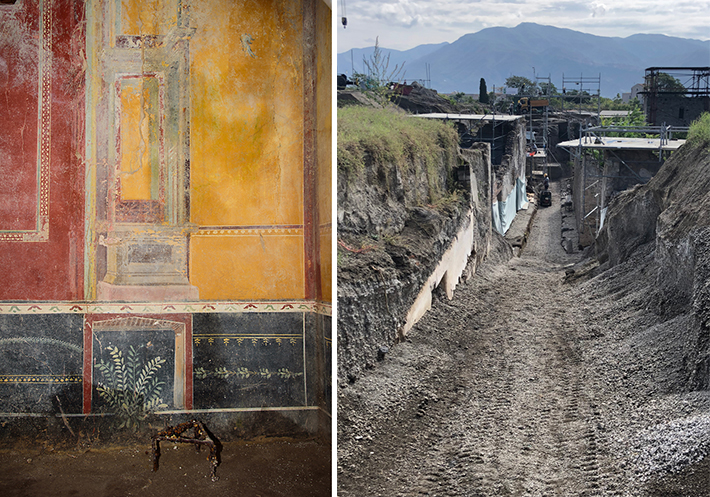 Despite more than 250 years of almost continuous exploration, fully one-third of the ancient city of Pompeii had never been excavated. In 2018, this all changed.
Despite more than 250 years of almost continuous exploration, fully one-third of the ancient city of Pompeii had never been excavated. In 2018, this all changed.
The A.D. 79 eruption of Mount Vesuvius left the city buried under volcanic material, creating a nearly perfect record of the day’s activities—bread baking in ovens, houses under renovation, gardens being tended. But, in the unexcavated sections, all that mud, ash, and hardened bits of lava called lapilli has been collapsing and sliding toward previously excavated properties. This threatens the safety of both visitors and the ancient houses. “Something had to be done,” says Massimo Osanna, general director of the Archaeological Park of Pompeii.
The array of frescoes unearthed during the first large-scale excavations of the previously unexcavated area called Regio V, one of the nine regions into which archaeologists divide the city, has been truly extraordinary. And, says Osanna, “They are the first to be uncovered using the most up-to-date techniques of analysis, conservation, and preservation.”
Hominin Hybrid
By LYDIA PYNE
Monday, December 10, 2018
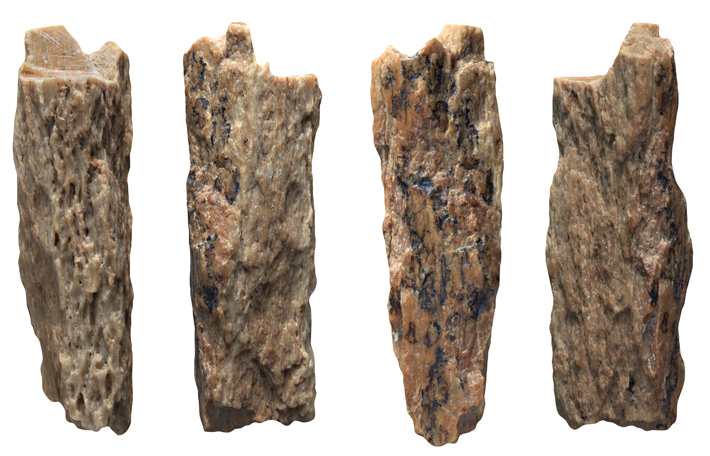 Genetic testing of a single, 90,000-year-old sliver of bone from an approximately 13-year-old girl has confirmed something researchers had long suspected: It has provided clear evidence of interbreeding between two distinct groups of early humans.
Genetic testing of a single, 90,000-year-old sliver of bone from an approximately 13-year-old girl has confirmed something researchers had long suspected: It has provided clear evidence of interbreeding between two distinct groups of early humans.
Earlier analysis of the girl’s mitochondrial DNA had shown that her mother was of Neanderthal ancestry. The new research, led by paleogeneticists at the Max Planck Institute for Evolutionary Anthropology, examined her entire genome. They then compared it to previously sequenced paleogenomes, including those of other ancient humans. The results were unambiguous—the girl’s DNA matched Neanderthal and Denisovan genomes to an equal degree. She had a Neanderthal mother and a Denisovan father. Denisovans were a type of early hominin named after the cave in the Altai Mountains of present-day Russia where their remains were found around a decade ago. “When I first saw the combined Neanderthal and Denisovan ancestry, I got worried that I had made a mistake in the lab, and that this was somehow a mix-up of two different bones,” says Max Planck’s Viviane Slon. “It was only after repeating the experiments several times, and consistently seeing the same result, that I convinced myself—and my colleagues—that the girl’s mixed ancestry was real.”
The team’s finding of a direct offspring of a Neanderthal and a Denisovan implies that individuals from the two groups mixed when they had the opportunity to meet. “Taken together with evidence that Neanderthals and Denisovans also mixed with ancient modern humans,” says Slon, “this suggests that different groups of humans have always mixed when encountering each other.”
Mummy Workshop
By JASON URBANUS
Monday, December 10, 2018
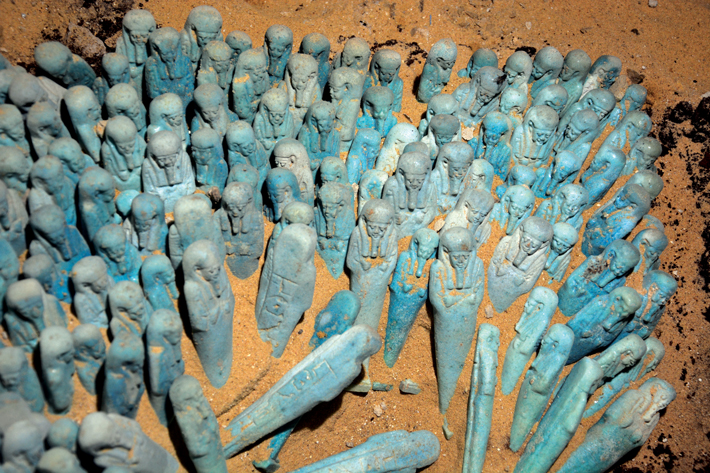 At the vast Egyptian necropolis of Saqqara, German and Egyptian archaeologists have unearthed a type of ancient funeral parlor. This establishment, the first of its kind ever identified, provided mummification services as well as communal burial chambers for the dead. It has revealed tantalizing new clues to how mummies were made during the Saite-Persian period of the mid-first millennium B.C. The rectangular building, composed of mudbrick and limestone blocks, contained large vats where bodies and linens were prepped for preservation. At the bottom of a 40-foot-deep shaft, the team found an embalming chamber where hundreds of ceramic bowls and cups were stored. Many of these vessels had labels listing specific oils and substances, along with instructions for how they should be used in the mummification process.
At the vast Egyptian necropolis of Saqqara, German and Egyptian archaeologists have unearthed a type of ancient funeral parlor. This establishment, the first of its kind ever identified, provided mummification services as well as communal burial chambers for the dead. It has revealed tantalizing new clues to how mummies were made during the Saite-Persian period of the mid-first millennium B.C. The rectangular building, composed of mudbrick and limestone blocks, contained large vats where bodies and linens were prepped for preservation. At the bottom of a 40-foot-deep shaft, the team found an embalming chamber where hundreds of ceramic bowls and cups were stored. Many of these vessels had labels listing specific oils and substances, along with instructions for how they should be used in the mummification process.
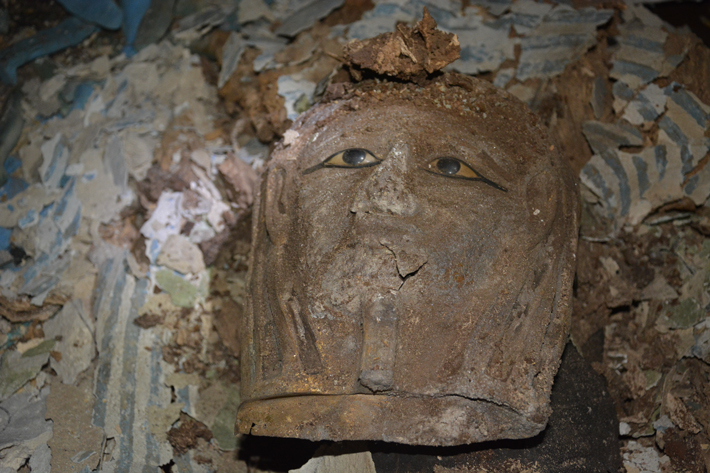 From the workshop’s open courtyard, a nearly 100-foot-long tunnel led down to a series of burial chambers that contained dozens of mummies. One stone sarcophagus, belonging to a lady named Tadihor, was surrounded by dozens of protective faience ushabti figurines inscribed with her name. A painted and plastered wooden coffin identified its occupant as the second priest of the mother goddess Mut and a priest of the goddess Niut-shaes, a serpent form of Mut. Placed over the mummy’s head was a rare gilded silver mask, with inlaid calcite, obsidian, and onyx eyes. “Gilded silver masks had deep religious meaning,” says project leader Ramadan B. Hussein of the University of Tubingen. “Egyptian religious texts indicate that the bones of the gods are made of silver and their flesh is made of gold. A mummy mask of silver and gold is a step toward the transformation of the deceased into a god.”
From the workshop’s open courtyard, a nearly 100-foot-long tunnel led down to a series of burial chambers that contained dozens of mummies. One stone sarcophagus, belonging to a lady named Tadihor, was surrounded by dozens of protective faience ushabti figurines inscribed with her name. A painted and plastered wooden coffin identified its occupant as the second priest of the mother goddess Mut and a priest of the goddess Niut-shaes, a serpent form of Mut. Placed over the mummy’s head was a rare gilded silver mask, with inlaid calcite, obsidian, and onyx eyes. “Gilded silver masks had deep religious meaning,” says project leader Ramadan B. Hussein of the University of Tubingen. “Egyptian religious texts indicate that the bones of the gods are made of silver and their flesh is made of gold. A mummy mask of silver and gold is a step toward the transformation of the deceased into a god.”
Ancient Shipwreck
By JASON URBANUS
Monday, December 10, 2018
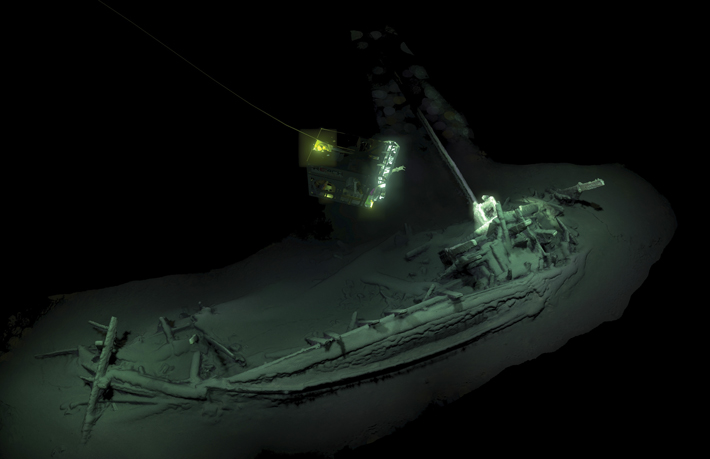 A Greek merchant ship discovered more than a mile under the surface of the Black Sea has been radiocarbon dated to 2,400 years ago, making it the world’s oldest known intact shipwreck. The vessel was located by the Black Sea Maritime Archaeology Project as they surveyed the seafloor some 50 miles off the coast of Bulgaria with a remote deep-sea camera system.
A Greek merchant ship discovered more than a mile under the surface of the Black Sea has been radiocarbon dated to 2,400 years ago, making it the world’s oldest known intact shipwreck. The vessel was located by the Black Sea Maritime Archaeology Project as they surveyed the seafloor some 50 miles off the coast of Bulgaria with a remote deep-sea camera system.
The 75-foot-long wooden ship remains remarkably well preserved because the Black Sea’s depths are oxygen-free. This has allowed experts to examine elements of ancient ship construction for the first time, including the design of the mast, twin rudders, and rowing benches. “A ship, surviving intact, from the Classical world is something I would never have believed possible,” says Jon Adams of the University of Southampton. “This will change our understanding of shipbuilding and seafaring in the ancient world.”
Advertisement
Advertisement
IN THIS ISSUE
Advertisement

Recent Issues
-
 May/June 2024
May/June 2024
-
 March/April 2024
March/April 2024
-
 January/February 2024
January/February 2024
-
 November/December 2023
November/December 2023
-
 September/October 2023
September/October 2023
-
 July/August 2023
July/August 2023
-
 May/June 2023
May/June 2023
-
 March/April 2023
March/April 2023
-
 January/February 2023
January/February 2023
-
 November/December 2022
November/December 2022
-
 September/October 2022
September/October 2022
-
 July/August 2022
July/August 2022
-
 May/June 2022
May/June 2022
-
 March/April 2022
March/April 2022
-
 January/February 2022
January/February 2022
-
 November/December 2021
November/December 2021
-
 September/October 2021
September/October 2021
-
 July/August 2021
July/August 2021
-
 May/June 2021
May/June 2021
-
 March/April 2021
March/April 2021
-
 January/February 2021
January/February 2021
-
 November/December 2020
November/December 2020
-
 September/October 2020
September/October 2020
-
 July/August 2020
July/August 2020
-
 May/June 2020
May/June 2020
-
 March/April 2020
March/April 2020
-
 January/February 2020
January/February 2020
-
 November/December 2019
November/December 2019
-
 September/October 2019
September/October 2019
-
 July/August 2019
July/August 2019
-
 May/June 2019
May/June 2019
-
 March/April 2019
March/April 2019
-
 January/February 2019
January/February 2019
-
 November/December 2018
November/December 2018
-
 September/October 2018
September/October 2018
-
 July/August 2018
July/August 2018
-
 May/June 2018
May/June 2018
-
 March/April 2018
March/April 2018
-
 January/February 2018
January/February 2018
-
 November/December 2017
November/December 2017
-
 September/October 2017
September/October 2017
-
 July/August 2017
July/August 2017
-
 May/June 2017
May/June 2017
-
 March/April 2017
March/April 2017
-
 January/February 2017
January/February 2017
-
 November/December 2016
November/December 2016
-
 September/October 2016
September/October 2016
-
 July/August 2016
July/August 2016
-
 May/June 2016
May/June 2016
-
 March/April 2016
March/April 2016
-
 January/February 2016
January/February 2016
-
 November/December 2015
November/December 2015
-
 September/October 2015
September/October 2015
-
 July/August 2015
July/August 2015
-
 May/June 2015
May/June 2015
-
 March/April 2015
March/April 2015
-
 January/February 2015
January/February 2015
-
 November/December 2014
November/December 2014
-
 September/October 2014
September/October 2014
-
 July/August 2014
July/August 2014
-
 May/June 2014
May/June 2014
-
 March/April 2014
March/April 2014
-
 January/February 2014
January/February 2014
-
 November/December 2013
November/December 2013
-
 September/October 2013
September/October 2013
-
 July/August 2013
July/August 2013
-
 May/June 2013
May/June 2013
-
 March/April 2013
March/April 2013
-
 January/February 2013
January/February 2013
-
 November/December 2012
November/December 2012
-
 September/October 2012
September/October 2012
-
 July/August 2012
July/August 2012
-
 May/June 2012
May/June 2012
-
 March/April 2012
March/April 2012
-
 January/February 2012
January/February 2012
-
 November/December 2011
November/December 2011
-
 September/October 2011
September/October 2011
-
 July/August 2011
July/August 2011
-
 May/June 2011
May/June 2011
-
 March/April 2011
March/April 2011
-
 January/February 2011
January/February 2011
Advertisement






